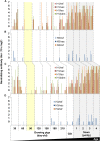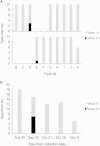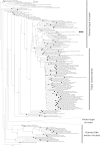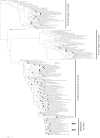Efficient isolation of Swine influenza viruses by age-targeted specimen collection
- PMID: 25694523
- PMCID: PMC4365228
- DOI: 10.1128/JCM.02941-14
Efficient isolation of Swine influenza viruses by age-targeted specimen collection
Abstract
The control of swine influenza virus (SIV) infection is paramount for increasing the productivity of pig farming and minimizing the threat of pandemic outbreaks. Thus, SIV surveillance should be conducted by region and on a regular basis. Here, we established a microneutralization assay specific for SIV seroprevalence surveillance by using reporter gene-expressing recombinant influenza viruses. Growth-based SIV seroprevalence revealed that most sows and piglets were positive for neutralizing antibodies against influenza viruses. In contrast, the 90-day-old growing pigs exhibited limited neutralizing activity in their sera, suggesting that this particular age of population is most susceptible to SIV infection and thus is an ideal age group for SIV isolation. From nasal swab specimens of healthy pigs in this age population, we were able to isolate SIVs at a higher incidence (5.3%) than those of previous reports. Nucleotide sequencing and phylogenetic analysis of the hemagglutinin (HA) genes revealed that the isolated SIVs have circulated and evolved in pigs but not have been recently introduced from humans, implying that a large number of SIV lineages may remain "undiscovered" in the global porcine populations. We propose that the 90-day-old growing pig-targeted nasal swab collection presented in this study facilitates global SIV surveillance and contributes to the detection and control of SIV infection.
Copyright © 2015, American Society for Microbiology. All Rights Reserved.
Figures




Similar articles
-
Surveillance of avian and swine influenza in the swine population in Taiwan, 2004.J Microbiol Immunol Infect. 2008 Jun;41(3):231-42. J Microbiol Immunol Infect. 2008. PMID: 18629419
-
Prevalence of swine influenza virus subtypes on swine farms in the United States.Arch Virol. 2002 Jun;147(6):1209-20. doi: 10.1007/s00705-002-0788-4. Arch Virol. 2002. PMID: 12111430
-
Swine influenza virus infection in different age groups of pigs in farrow-to-finish farms in Thailand.Virol J. 2011 Dec 14;8:537. doi: 10.1186/1743-422X-8-537. Virol J. 2011. PMID: 22166074 Free PMC article.
-
[Swine influenza virus: evolution mechanism and epidemic characterization--a review].Wei Sheng Wu Xue Bao. 2009 Sep;49(9):1138-45. Wei Sheng Wu Xue Bao. 2009. PMID: 20030049 Review. Chinese.
-
Sampling techniques for the diagnosis of digestive disease.Vet Clin North Am Food Anim Pract. 2000 Mar;16(1):23-36, v. doi: 10.1016/s0749-0720(15)30135-3. Vet Clin North Am Food Anim Pract. 2000. PMID: 10707412 Review.
Cited by
-
Effect of herd size on subclinical infection of swine in Vietnam with influenza A viruses.BMC Vet Res. 2016 Oct 10;12(1):227. doi: 10.1186/s12917-016-0844-z. BMC Vet Res. 2016. PMID: 27724934 Free PMC article.
-
Genetic Diversity of the Hemagglutinin Genes of Influenza a Virus in Asian Swine Populations.Viruses. 2022 Apr 1;14(4):747. doi: 10.3390/v14040747. Viruses. 2022. PMID: 35458477 Free PMC article. Review.
-
The epidemiology of swine influenza.Anim Dis. 2021;1(1):21. doi: 10.1186/s44149-021-00024-6. Epub 2021 Sep 28. Anim Dis. 2021. PMID: 34778883 Free PMC article. Review.
-
Swine influenza viruses in Northern Vietnam in 2013-2014.Emerg Microbes Infect. 2018 Jul 2;7(1):123. doi: 10.1038/s41426-018-0109-y. Emerg Microbes Infect. 2018. PMID: 29967457 Free PMC article.
-
Host Factors Affecting Generation of Immunity Against Porcine Epidemic Diarrhea Virus in Pregnant and Lactating Swine and Passive Protection of Neonates.Pathogens. 2020 Feb 18;9(2):130. doi: 10.3390/pathogens9020130. Pathogens. 2020. PMID: 32085410 Free PMC article. Review.
References
-
- Nardelli L, Pascucci S, Gualandi GL, Loda P. 1978. Outbreaks of classical swine influenza in Italy in 1976. Zentralbl Veterinarmed B 25:853–857. - PubMed
-
- Karasin AI, Schutten MM, Cooper LA, Smith CB, Subbarao K, Anderson GA, Carman S, Olsen CW. 2000. Genetic characterization of H3N2 influenza viruses isolated from pigs in North America, 1977-1999: evidence for wholly human and reassortant virus genotypes. Virus Res 68:71–85. doi:10.1016/S0168-1702(00)00154-4. - DOI - PubMed
-
- Van Reeth K, Nauwynck H, Pensaert M. 1996. Dual infections of feeder pigs with porcine reproductive and respiratory syndrome virus followed by porcine respiratory coronavirus or swine influenza virus: a clinical and virological study. Vet Microbiol 48:325–335. doi:10.1016/0378-1135(95)00145-X. - DOI - PMC - PubMed
Publication types
MeSH terms
Substances
Associated data
- Actions
- Actions
- Actions
- Actions
- Actions
- Actions
LinkOut - more resources
Full Text Sources

